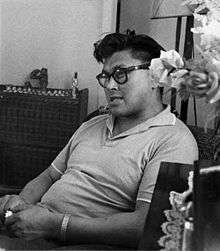Abe Okpik
| Abe Okpik | |
|---|---|
 Okpik in April 1964 | |
| Born |
12 January 1928 Mackenzie Delta area, Northwest Territories |
| Died |
10 July 1997 (aged 69) Iqaluit |
| Occupation | Inuit community leader |
Abraham "Abe" Okpik,[1] CM[2] (12 January 1928 – 10 July 1997[3]) was an Inuit community leader in Canada. He was instrumental in helping Inuit obtain surnames rather than disc numbers. He was also the first Inuk to sit on what is now the Legislative Assembly of the Northwest Territories[1] and worked with Thomas Berger.
Early life
Okpik (the name means "snowy owl" in Inuvialuktun), an Inuvialuit, was born in the Mackenzie Delta area of the Northwest Territories, near Aklavik at a summer fishing camp. As a youth he, like many other Aboriginal people, contracted tuberculosis and was sent to the Charles Camsell Hospital in Edmonton. Although he was permanently injured by his dog sled he was still able to hunt and trap.
1960s
By the 1960s, Okpik was living in what was then called Frobisher Bay, now Iqaluit. He was working at Apex, the subdivision where most Inuit lived in the town's early days, at the rehabilitation centre. He was later to work for Department of Indian Affairs and Northern Development (DIAND) as an administrator.
In 1965 Okpik was appointed to the Northwest Territories Council (5th Northwest Territories Legislative Council). At that time most of the council were from Ottawa. Okpik's role on the council was to serve as a representative for the Inuit population resident in the eastern arctic. He was not re-appointed to council after Simonie Michael was elected to the council in the 1967 general election. The government of Canada felt that Michael would serve Okpik's intended role and gave his seat to Chief John Tetlichi the first status Indian to serve on council.[4]
Project Surname
Since the 1940s the Government of Canada had used "disc numbers" to identify Inuit due to the lack of need in historical times for surnames. In the mid-1960s the Northwest Territories Council undertook to replace the disc numbers with last names under "Project Surname". Okpik, whose disc number was "W3-554", was picked to head the project. From 1968 until 1971 he visited every community, as well as many traditional campsites, in the Northwest Territories, what is now Nunavut and Nunavik in northern Quebec.[5] At each place Okpik would record the names, sometimes first as well, that people wanted and would sometimes have to explain the necessity for the names.[6]
The Berger Commission
In 1974 the Government of Canada commissioned Thomas Berger to head the Mackenzie Valley Pipeline Inquiry. The inquiry lasted longer and travelled further than was expected, through 35 northern communities,[7] and Okpik accompanied Berger as both an interpreter and broadcaster.
Order of Canada
In recognition of Okpik's work with the "Berger Commission", on the NWT Council and for "Project Surname" he was made a "Member of the Order of Canada". The appointment was made 15 December 1976 with the investiture 20 April 1977.
Later life and death
In 1979 he returned to Iqaluit but had spent time on Banks Island and in Spence Bay, now Taloyoak.
Okpik spent the rest of his life in Iqaluit and was an elected member of the town council on several occasions. He also served on several volunteer organisations and committees. Okpik died in Iqaluit 10 July 1997 after an illness and his funeral service was held in St. Jude's Cathedral 15 July.
The "Abe Okpik Hall" in Apex[8] is named for him. The former mayor of Iqaluit, Jimmy Kilabuk, had a mural painted on the side of his home in 1998 that included Okpik.[9]
References
- 1 2 Arctic residents say farewell to the humble name-giver
- ↑ Order of Canada citation
- ↑ Abe Okpik on Tamapta, an InuvialuitTelevision program on YouTube interview starts at 20:48
- ↑ "N.W.T. Seat to Barber". Vol LVIII No 263. The Leader Post. November 10, 1967. p. 4.
- ↑ Hanson, Ann Meekitjuk. "Nunavut 99 - What's In A Name? Names, as well as events, mark the road to Nunavut". Nunavut.com. Retrieved 2009-10-03.
- ↑ katilvik.com Glossary
- ↑ Natives Speak Out Archived October 12, 2006, at the Wayback Machine.
- ↑ "Iqaluit this week" Nunatsiaq News December 23, 2005
- ↑ Community group sponsors public art in Nunavut's capital Nunatsiaq News July 16, 1998
External links
- Elders' stories - Abe Okpik
- What Does It Mean to Be an Eskimo? by Abe Okpik
- "WHAT'S IN A NAME?" by Ann Meekitjuk Hanson Commissioner of Nunavut, in which she remembers Abe Okpik